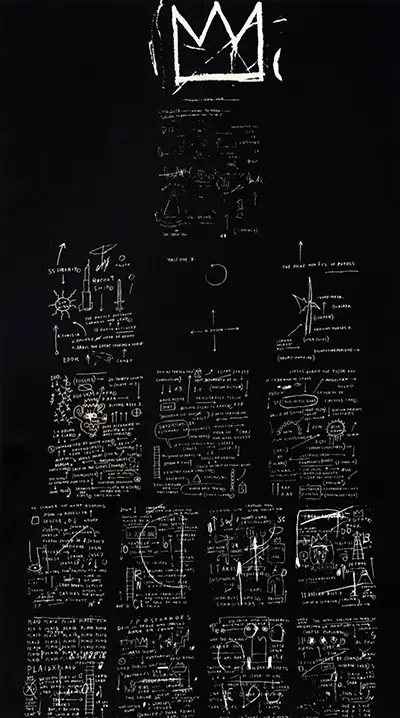SAMO wrote epigrams on the streets and buildings of Manhattan, New York City, aiming to awake greater cultural awareness and reflection in its inhabitants.
Throughout his life, both his graffiti and his neo-Expressionist paintings (which were exhibited in US art galleries whilst he was still early in his career) enabled him to voice his criticism of racism, class inequalities and colonialism.
Basquiat loved to blend symbols with poetry and epigrams. His works often revolve around clear dichotomies, such as rich vs poor, segregation vs integration and our inner lives vs the external world.
His key influences were hip hop and post punk music as well as the street art scene in NYC. Many if his works are very abstract and symbolic, and this is certainly the case with Tuxedo.
When hearing the title of this work, viewers might expect that they are going to see a portrait of a person wearing a tuxedo, however this is not the case. Instead, Basquiat has sprayed a crown onto the surface of the paper.
This crown image appears elsewhere in Basquiat's work, too, Perhaps he chose it because it has such obvious symbolism. A crown is a symbol of riches and power, and, by implication, it suggests the opposite: poverty and disenfranchisement.
Given that Basquiat's work revolved so much around documenting class struggle and critiquing power imbalances, it is safe to say that for him a crown did not symbolise something to be lauded, but, rather, was a symbol of inequality.
What Tuxedo depicts, then, is not a literal tuxedo but what a tuxedo represents in the abstract. Like the monarch's crown, a tuxedo is a symbol of power, and thus of power imbalances and inequalities within society.
Thus it is safe to say that Tuxedo is one of Basquiat's highly abstract and figurative works. This crown image has become something of a symbol of Basquiat's work, life and ideals - it appears above his name on his official website, for example. Perhaps, it could even be described as part of his signature.



